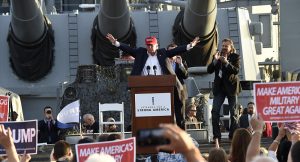2017-03-29 By Robbin Laird
President Trump has come to office at a strategic turning point for US forces.
The forces face significant readiness shortfalls which will take time and money to repair but the key question will be readiness to do what?
The President can shape a flexible 21st century combat force built around modern multi-mission systems, or continue down the path of supporting an air and sea supported ground combat force.
The alternative would be to reshape the ground combat force as part of an integrated air and naval force prepared for 21st century operations.
And such a force needs to be able to pivot across the range of military operations and to do so very rapidly.
Aspirational statements, or good intentions will not build a 21st century combat force.
Putting in place a team which can build out a fifth generation warfare force and resourcing that force will.
Yet choices to be made in the Middle East may predetermine the outcome.
The engagement in a long and sustained ground operation will make any discussion of investment in shaping a high intensity warfighting force largely irrelevant,
Sunk costs in land wars may count as parts of a large % in defense spending but get you nowhere on the path to recapitalizing a 21st century combat force, one which will be directly challenged by North Korea, Russia, and China, not name just three players.
The question of defense budget spending can be eaten alive by operations and readiness shortfalls being made up and not getting to the point of getting the force, which you would really wish to have for 21st century combat operations.
This would require modulating ops tempos by making tough decisions on when and how long to deploy as well directing readiness money into recapitalization.
 A recapitalized legacy force or force transformation?
A recapitalized legacy force or force transformation?
NDIA highlighted this dilemma in part for the Army as follows:
President Trump’s proposed military buildup would pump billions of dollars into Army coffers, but little of that money will be spent to design and develop new weapon systems. Cutting-edge Army projects that the defense industry has awaited for years — the development of a new tank, driverless combat vehicles or ultramodern high-speed helicopters — may not be acquired for decades.
“The Army’s initiatives to regain and sustain readiness have come at a cost to modernization, Lt. Gen. Joseph Anderson, Army deputy chief of staff, told the House Armed Services Committee’s readiness subcommittee.
Senior Army leaders — notably Lt. Gen. HR McMaster, who is now Trump’s national security adviser — have called on the military to accelerate development of next-generation systems and to take technological leaps to ensure it is not overmatched in future wars.
That type of aggressive modernization is not in the cards, at least in the next five years, as the Army will have to spend most of its equipment dollars on systems it already has in production.
“There is no money to invest in long-range projects,” says Hamilton Cook, senior market analyst at the consulting firm Avascent, in Washington, D.C. “The president wants to grow the force by 90,000 troops. That eats up a lot of operational and equipment funding.
http://www.nationaldefensemagazine.org/blog/Lists/Posts/Post.aspx?ID=2438
And in shaping a 21st century high intensity combat force, the question of the integration of new nuclear weapons into the strike force is a key consideration.
The President has promised to address the question of nuclear modernization but this needs to be done not from a legacy triad point of view but from a credibility of warfighting point of view.
The Second Nuclear Age is here and simply rebuilding yesterday’s nuclear force is not going to get the job done.
The danger of course is simply that there is no real force transformation and that investments simply go into legacy equipment and continuing legacy mindsets of how you build, deploy and fight.
One can easily see the future when visiting 21st century force elements, such as the F-35 squadrons or the P-8/Triton squadrons. I have just done so in the United Kingdom and will do so again in my upcoming visit to Australia.
They get the transition and understand it is about shaping a distributed combat force with C2 at the point of attack.
This is simply is not achievable by legacy equipment, legacy operational constructs and thinking.
But will the President put in place a cadre of decision makers who can shape such a force?
This remains to be seen and the costs of not doing so will be very high for the United States and its allies.
Indeed, a number of key allies are moving out on shaping new force structures and new approaches.
Clearly, the US has a unique leadership opportunity, but this opportunity will not be realized by simply rebuilding yesterday’s force.
And the US will be doing so not in a benign combat environment but one ripe with adversaries in the throws of their own force modernization.
There is always the reactive enemy to consider.
In short, we are a key turning point for the U.S. forces as they await key decisions on force modernization.
But simply buying more of yesterday’s platforms and air systems is not going to get us there.
It is about getting on with a force which can deliver on distributed lethality, coalition interoperability and kill webs.

